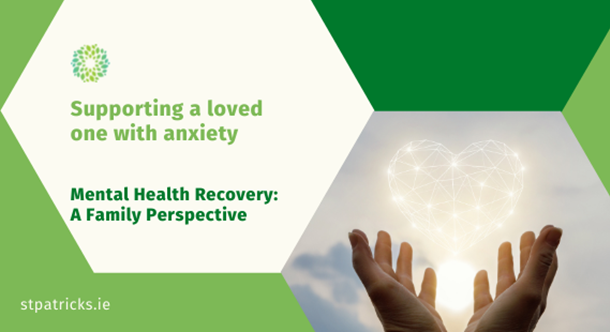
Many of us know or support people experiencing high levels of anxiety. It’s important that we understand where this anxiety comes from and how we can help the person to deal with it.
Frank Smith of the Anxiety Disorders Programme here in St Patrick’s Mental Health Services (SPMHS) explores what anxiety is, what treatment for anxiety looks like, and how we can support people going through it.
What is anxiety?
Anxiety is our natural response to potentially threatening future events or situations. We are constantly interpreting, or trying to make sense of, everything that is going on around us, whether it is good or bad, safe or dangerous, and so on. We also try to use the information we get in the moment to try and anticipate, or predict, what might happen next. When we take or interpret information to mean that there is something potentially dangerous or difficult in our future, we will start to feel anxious.
When anxiety occurs within the appropriate context, it can be very helpful. Anxiety enables us to more quickly identify and cope with threats before they can hurt us. It focuses us to perform well and to concentrate on what’s needed to safely handle or navigate these tricky situations.
It does this through physical, cognitive, emotional and behavioural changes:
- Our bodies go into "fight or flight" mode, prioritising oxygen and bringing energy to the large muscle groups linked with running or fighting.
- How we think changes, focusing on and prioritising the source of our anxiety. This is why, often, if we are anxious about something it can be very difficult to focus on or think about anything else.
- We feel afraid, a difficult and uncomfortable emotional state that motivates us to try and escape, avoid or otherwise neutralise potential threats.
- We can start to behave differently when we are anxious or afraid and will try to avoid, escape or somehow neutralise the perceived threat.
Anxiety is closely related to fear, both being responses to a perceived threat or potential threat. The difference between anxiety and fear is that anxiety happens when there is no immediate threat or danger to us, and fear occurs when there is a real or urgent threat of harm to us. For example, if you were to hear news of a lion escaping a zoo in your town, this might cause you to feel more anxious than usual: there is no imminent threat but you know that there is a potential new threat that might make things dangerous in the future if you go outside, and so on. If you were to look out your window and see a lion sitting outside you might feel fear, as this is an imminent and tangible threat to your safety that must be acted on immediately.
When is anxiety a problem?
If we start to experience excessive anxiety, or anxiety that disrupts our ability to live our lives the way we want to, it may be becoming a problem for us.
Excessive anxiety could be described as:
- Feeling anxious when there is no significant danger or difficulty
- Feeling more worried than would be expected in a situation
- Inflating or overestimating the likelihood of harm or chances of something bad happening
- Inflating or overestimating the level of danger.
Excessive anxiety can be a symptom of a wide variety of mental health difficulties, including depression, bipolar affective disorder, as a result of psychosis or psychotic phenomena, or as a result of certain personality traits, such as perfectionism or low self-esteem.
It can also be part of an anxiety disorder - like generalised anxiety disorder (GAD), social anxiety, or panic disorder - or a part of a different mental health condition.
Can anxiety be treated?
Anxiety is very treatable.
It’s important to treat the cause of the anxiety and not the symptoms. This is because the treatment for anxiety caused by one thing, such as depression, will be different to the treatment for anxiety caused by another, such as low self-esteem or social anxiety. While anxiety can be unpleasant and uncomfortable in itself, the most effective treatments for it are those which target the reasons it happens, rather than just the feelings of anxiety themselves. This requires accurate diagnosis from and engagement with mental health professionals.
Talking therapies can be very effective in treating excessive anxiety and its causes. Cognitive Behavioural Therapy (CBT) is well-researched and evidenced for anxiety linked to anxiety disorders and depression. CBT supports the person with excessive anxiety to discover more about what is causing them to feel anxious, to explore whether it is truly dangerous or not and ultimately to challenge any inaccurate or distorted thoughts or cognitions that may be resulting in high anxiety. CBT also supports the person to reduce and eliminate any safety-seeking behaviours that are being used to manage the perceived threat but that may actually maintain and reinforce anxious thoughts or cognitions while doing so.
Other modes of psychotherapy can also help us to cope with anxiety: therapeutic modalities, or types of therapy, such as Compassion-Focused Therapy (CFT) or Acceptance and Commitment Therapy (ACT) can be useful for anxiety coming from places like low self-esteem, while Dialectical Behavioural Therapy (DBT) can be helpful for anxiety relating to certain personality styles.
Medication can have a role to play. For example, antidepressant medication can be effective in lowering excessive anxiety experienced as a result of a mental health difficulty, whether a specific anxiety disorder or through another condition such as depression. Medication can also be very helpful in increasing our ability to engage in psychotherapeutic treatment, or talk therapy.
How can I support someone with anxiety?
If you are supporting someone who has anxiety or is experiencing an anxiety disorder, some general guidelines you might find helpful are below.
Be empathetic
Grow and cultivate empathy. Remember, what you experience in a situation is not what the person with an anxiety disorder is experiencing. For instance, if both of you were waiting outside a room for a job interview, you might feel nervous, but they might feel overly anxious. You are both in the same situation, but your assessments of it are completely different. The emotional states you walk into the interview in will be very different. It’s important to be compassionate to the person. One way of doing this is to try thinking of something that does make you anxious and reminding yourself that the person is having the same kinds of feelings you would have in that moment.
Support and facilitate treatment
There are a lot of treatment options for anxiety; these can require commitments of time and effort. One of the best things you can do in supporting someone with anxiety is to facilitate them as much as possible in attending appointments – such as assessments or therapy sessions – and giving time to allow them to do “homework” from therapy, and so on.
Be open and prepared
People often use safety behaviours or seek reassurance when they have high levels of anxiety, but these can often reinforce the anxiety and make it worse over time. For example, when they are anxious, a person might tend to look for reassurance that everything will be ok; while that reassurance will relieve them in the moment, it can lead to a reduced tolerance for uncertainty in the long-term.
Wait for a time that someone is outside of a high state of anxiety, and then develop a plan with them for what to do when the anxiety comes up again. For instance, if a person with Obsessive Compulsive Disorder insists, when they are feeling anxious, that their family members wash their hands, the plan might be to enact something they’re learning in therapy and encourage them not to wash hands the next time those feelings come up. It’s important to have these conversations at a time outside of a highly anxious or crisis situation so that everyone is clear on what the best way to approach a such situation is.
Support the person, not the anxiety disorder
As previously stated, our behaviour changes when we are anxious or fearful, and, often, we will want to neutralise or escape the anxiety-provoking situation as quickly as possible. In the case of anxiety disorders, these neutralising or escaping behaviours are not supportive of reducing anxiety long-term and only make challenging anxious thoughts or cognitions more difficult. A similar situation might be if someone was giving up cigarettes and was distressed during a strong craving. It might be hard to see them upset; offering them a cigarette at that time might ease their distress for a short time, but would set them back in achieving their longer term goal of give up smoking. It’s the same when someone is going through recovery for anxiety. Often, what may reduce anxiety quickly in the moment may reduce the effectiveness of treatment.
When someone is feeling very anxious due to an anxiety disorder, be supportive and acknowledge their distress. Try to do this in a way that does not neutralise the perceived threat for the person. This is why conversation and preparation with the person going through anxiety are so important; this allows us to plan responses that support and complement treatment goals, rather than just solve the immediate difficulty.
Support positive changes
When someone feels like they are in danger, it can be upsetting and uncomfortable, but, with anxiety disorders, it is also an opportunity to learn some new information about whatever is making us anxious. This makes it important to promote experiential learning around the subject of the person’s anxiety. For example, if someone is afraid of heights, something we can help with is to make it as easy as possible for them to learn through experience what it is like to be up on a height. It is very difficult to learn whether heights are dangerous or not while standing on the ground!
Make it as easy as possible for the person to experience the situations that make them anxious, which allows for new learning that can ultimately be used to challenge anxious thoughts or cognitions. Support any positive changes the person is making towards learning about the situation. When the person is approaching the subject with curiosity rather than retreating to safety, this is something to applaud and to support them doing.
Learn more about anxiety
You can find some more information and resources about anxiety below. If you are worried that you or someone you know is going through anxiety, reach out.
Continue to…
A day in the life of a psychiatric nurse


